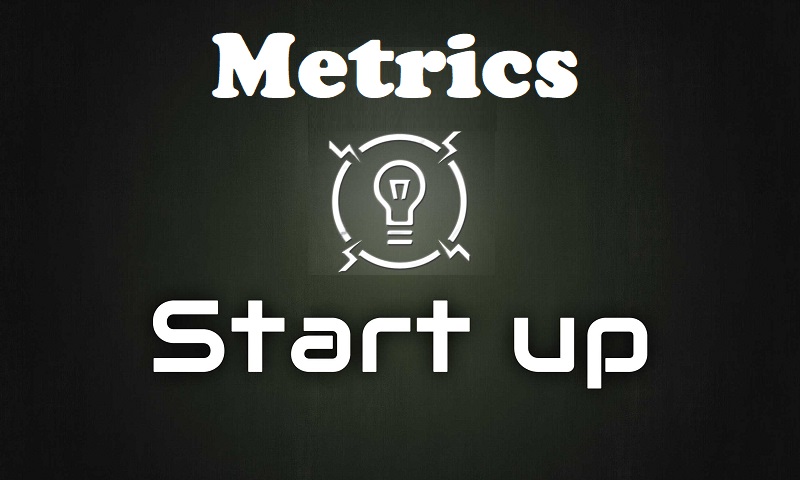If we talk about the Metrics for Startups, great results and short deadlines to get them are very common challenges of most business anywhere in the world. With reduced teams, limited funding and less time, the effort and willingness to take off on the market end up being the fuel of those entrepreneurs who pursue their dreams, taking with them their worksheets and applications that help them monitor the many metrics for startups they need be overcome.
After all, each and every organization aims at generating results and defining what those results are is usually the first step to success. This is where performance indicators come in. How many customers do you want to reach? What will be the sales target? What profit margin do you want? Remember that you cannot draw a goal beyond the reach of the team – you run the risk of discouraging those involved.

Metrics for startups are the basis for business benchmarking
While it is not advisable to practice absurd goals, you cannot set goals too easy, because you would be risking losing growth potential. And it goes without saying that these goals will serve as the basis for benchmarking your startup, that is, your point of comparison to identify whether the results achieved in a given time span are good or bad.
That’s why, after defining what results the company will seek, you have to monitor performance periodically, even to make adjustments when necessary. That’s when the metrics come in, helping to keep the search for the goals aligned with the reality and financial need of the startup.
With that in mind, let’s review the top 5 Metrics for Startups that every entrepreneur needs to pursue to keep the business active and competitive. Let’s find out?
1. Customer acquisition cost
One of the most important metrics in any type of business, Customer Acquisition Cost (CAC), can be obtained by dividing all the amount invested in marketing and sales by the number of customers acquired in a specific period. This is an indispensable indicator because, by itself, it can already indicate if the business is spending more to bring in new customers than, properly, profiting from their coming.
It is worth remembering that this calculation takes into account, in addition to the amounts invested in marketing, the entire cost of developing the campaigns, salaries, charges and benefits of call center staff and vendors, commercial reimbursements, discounts granted, material impressions and all any cost is directly linked to the sales objective.
But, once the entrepreneur has this cost in hand, how to relate it to cash flow? Simple: Just knowing that keeping track of this metric is important because if you are investing incorrectly at that point, your CAC is likely to be higher than LTV (Lifetime Value), a practice that has a great chance of leaving your business without a box in a very short time.
2. Lifetime value
Immediately following the CAC, you must pay close attention to the metrics for startups known as Lifetime Value (LVT) of your customers. In startups, the lifetime value is literally the net monetary value raised for your business over the estimated life of your company’s relationship with the customer. In other words, how much money an average customer spends during the time they spend consuming your product or service, at least until that relationship comes to an end.
Understanding this number and especially its relation of proportionality with CAC is fundamental for the construction of a sustainable company. Imagine, for example, that your company spends an average of $1,000 to acquire a new customer (CAC). In contrast, its indicator (LTV) shows that, on average, a new customer leaves $800 of net revenue during their relationship time. Result? Your company is growing without making a profit and without sustainability, a long-term risk not only for cash flow, but for the entire startup financial health.

3. Lost customer rate
A heavily weighted metric for businesses that work with Software as a Service (SaaS) and recurring revenue, the lost customer rate helps the entrepreneur make the necessary adjustments to the operation when a problem is detected. Also known as “churn rate”, this indicator can be obtained by dividing the total number of customers who canceled subscriptions by the total number of active subscribers in the base.
Of course, the ideal scenario for any business is one in which customers never cancel a service and therefore it is difficult to accurately determine what a “good” churn rate would be. However, knowing this number helps a lot in the search for alternatives to reduce it, a task that can be fulfilled with a good work of customer development, user experience and improvement in service, for example.
One tip is to remember that when we speak in percentage terms, the most indicated is that your metrics for startups grows at a rate always higher than the churn rate. And just as in the case of CAC, tracking this indicator is extremely important to identify if your investment of time and money in ensuring sales growth is not being impacted by a high number of cancellation of signatures, resulting in a flow of always negative.
4. Cost of product sold (CPV) and cost of service rendered (CSP)
These two metrics for startups deserve special attention to their definitions: while the cost of product sold (CPV) considers the division between sales value and direct costs of production or acquisition of product for resale, cost of service provided (CSP) covers the direct labor costs and material application. Here, the calculation usually considers very traditional values such as taxes, commissions and freight, but also includes everything that is considered cost of maintenance of the technology created, such as the cost of programmers’ labor; help desk and other direct expenses to support the product.
These are the metrics for startups that help the entrepreneur to know and know precisely how much your product or service costs, and consequently, to know what the fair price to practice in the market. Remember that if these metrics are neglected, your business may realize too late that the solution is not to sell more, but to increase its selling price or lower its direct costs of production and maintenance. If you have zero or negative individual margins, for example, selling more will only leave your cash flow more and more compromised.

5. Burn rate
It is one of the most dynamic metrics for startups also known as cash burn rate. The burn rate goes to show the speed at which your startup cash reserves are running low due to the expenses and investments in a specific period. Because it is a very dynamic metric, it is recommended that monitoring be done with a certain frequency, quarterly for example. For the calculation, it is enough to divide the total of the current assets of a quarter by the total of the current assets of the following semester.
But beware: when analyzing the burn rate alone in a chart, it is natural for the burning of capital to frighten the entrepreneur, since he only lists the money that is gone. Therefore, and even for the sake of comparative analysis, the ideal is that this metric should always be studied in relation to the margin of safety index and the break-even point of sales.

Control metrics for startups to conquer your success stories
If we start from the premise that most startups will operate with negative cash flow-either because they have not reached the break-even point or because they want to conquer the market faster-these are some of the metrics that will allow entrepreneurs and investors estimate the lifetime of a startup until its next round of funding.
And knowing how much time a company has until its next capture is especially important because they all need to come up with success stories right now to tell investors. After all, pulling out that dreamed-up paper project will always require extra effort, a lot of creativity, and skilled teams to perform their tasks. And if this is the support you need, talk to us or leave a comment here on the blog!


